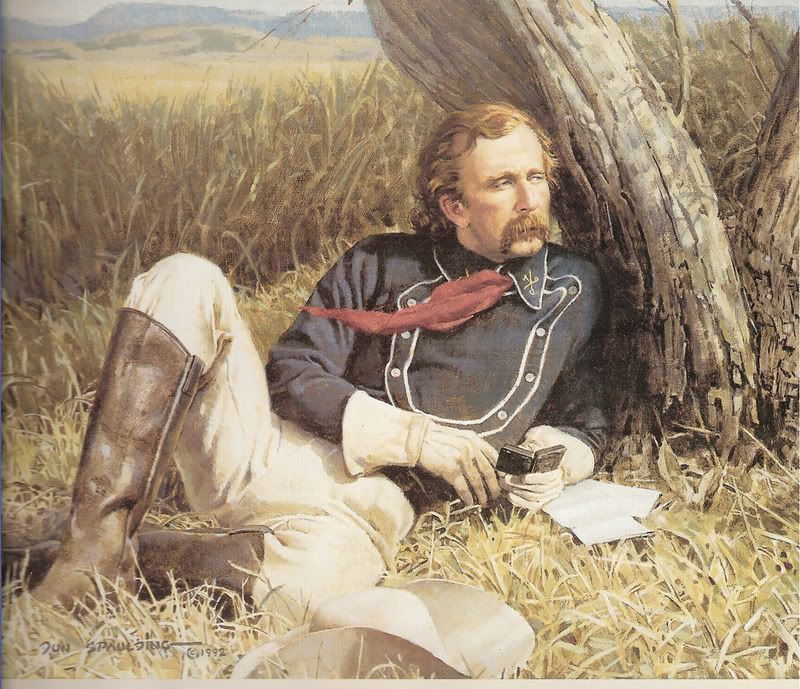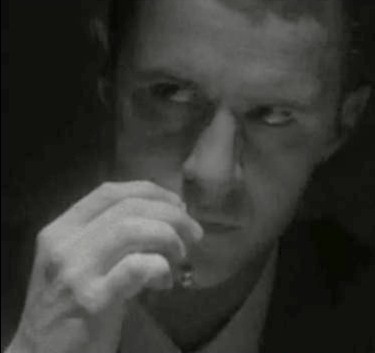Post by elisabeth on Oct 17, 2007 9:15:49 GMT -6
This just about comes under the heading of "Other People ... and Events", so I hope it's OK to put it here. The Custer connections are tenuous and infrequent, as you'll see -- but it's quite a story!
Apologies if this is of no interest to anyone. But you know how it is when you suddenly find snippets of new stuff; the urge to share them is irresistible.
(Thanks again, Billy, for that New York Times link of yours, from which much of this comes.)
Captain (Bvt. Lt-Col.) David Hillhouse Buel was a classmate of Custer's at West Point. He came 10th in the class, while Custer, as we know, came 34th. Thanks to that higher standing, he was able to go into the posher arm of the service, the artillery.
His Civil War service was distinguished. He was captured and imprisoned at Macon in 1864; when prisoner exchanges were discussed between Sherman and Hood, the two individuals Sherman initially asked for by name were Stoneman and Buel. (He must have added Keogh to the list later.) The Macon prisoners were removed to Charleston, which is where Stoneman and Keogh were held, so I think we can take it that Keogh and Buel knew each other.
Which was nice because ... in late 1869, Buel became commandant of the Arsenal at Fort Leavenworth, where the 7th Cavalry was based in the winter of '69/'70. So Custer found an old acquaintance there, and so did Keogh. Little wonder that Rebecca Richmond's diary shows the Custers, the Buels, and Keogh socialising together all the time. The Buels were also on good social terms with Sturgis and family.
(Oh, and among those visiting the Buels at Leavenworth in the spring of 1870 were Mrs. Buel's brother, Lt. McDougall, and his friend Lt. Calhoun. They must both have liked what they saw of the 7th Cavalry, since before many months were out they'd both joined it.)
Now the story takes a dramatic turn. In the summer of 1870, Custer and most of the 7th had returned to the field; Sturgis remained at Leavenworth. According to the NYT's account, Buel was returning home from a dinner at the Sturgis house -- when he was shot down and killed.
This appears to have taken place on July 22nd. The papers were full of it for some days afterwards, calling it an "assassination" rather than a murder. And it appears they were right.
The actual killer was swiftly identified as a Private John M. Malone, a deserter from the Ordnance Department. He was still on the run until July 26th, when he turned up at the home of the engineer of the Arsenal and attempted to extort money from the ladies of the house. He escaped; the alarm was raised; Malone got hold of a gun; a group of citizens moved to arrest him, there was a fight, and Malone was fatally wounded. It later emerged, however, that the gun belonged to an accomplice named Ackley, who was prepared to tell all in exchange for immunity; "three or four other men" were also arrested as accomplices. So -- a Grade A conspiracy.
Malone died the following day, after making a deathbed confession. He said his motive was that Buel "had compelled him to saw a cord of wood as a punishment for absence at roll call".
However, the Buel family's dramas didn't end there. The Buels had two young children: David, then aged 8, and Violet, aged 4. Whether the assassination scarred them for life or not is hard to tell; but their lives certainly followed curious paths. Their mother, Josephine, remarried in December 1875, marrying a relative of her husband's, Oliver Prince Buel. He, by the time of his death in 1899, was a distinguished attorney, heading up his own law firm (Buel, Toucey and Whiting). Despite the tragedy, then, it would seem likely they enjoyed a pretty comfortable and secure childhood.
David made the more spectacular headlines of the two. Having first caused shockwaves by becoming a Jesuit priest -- rising to be President of Georgetown University -- he then caused yet more by falling in love with the woman who nursed him through an illness; in 1913, he renounced his vows and married her. Just to make sure no-one got bored, in 1925 he was in the newspapers again, this time for deciding to become an Episcopal minister.
Poor Violet reached the public eye in a less happy manner. In January 1899 (at the rather late age of 33, then) she married the writer and literary critic George Merriam Hyde. Sounds good; a man of standing, talent, and sensibility, and with a nice address on Fifth Avenue ... It wasn't to last. By April 11th of that year, he'd disappeared. Two months later, his body was fished out of the Hudson River. The consensus was that he'd drowned himself in a fit of despondency over the death of his father-in-law Oliver P. Buel, whose funeral (in Troy, N.Y.) had taken place the day before his disappearance; apparently he'd been "greatly upset" by it and "talked of it constantly".
There may have been more unlucky families -- the Kennedys, for instance -- but few, perhaps, quite so beset by crisis as the Buels ...
All right; of small relevance to Custer, I'll admit. (Even though Josephine's photograph was present at LBH, having been carried into battle by Keogh.) But -- fascinating, eh?
Apologies if this is of no interest to anyone. But you know how it is when you suddenly find snippets of new stuff; the urge to share them is irresistible.
(Thanks again, Billy, for that New York Times link of yours, from which much of this comes.)
Captain (Bvt. Lt-Col.) David Hillhouse Buel was a classmate of Custer's at West Point. He came 10th in the class, while Custer, as we know, came 34th. Thanks to that higher standing, he was able to go into the posher arm of the service, the artillery.
His Civil War service was distinguished. He was captured and imprisoned at Macon in 1864; when prisoner exchanges were discussed between Sherman and Hood, the two individuals Sherman initially asked for by name were Stoneman and Buel. (He must have added Keogh to the list later.) The Macon prisoners were removed to Charleston, which is where Stoneman and Keogh were held, so I think we can take it that Keogh and Buel knew each other.
Which was nice because ... in late 1869, Buel became commandant of the Arsenal at Fort Leavenworth, where the 7th Cavalry was based in the winter of '69/'70. So Custer found an old acquaintance there, and so did Keogh. Little wonder that Rebecca Richmond's diary shows the Custers, the Buels, and Keogh socialising together all the time. The Buels were also on good social terms with Sturgis and family.
(Oh, and among those visiting the Buels at Leavenworth in the spring of 1870 were Mrs. Buel's brother, Lt. McDougall, and his friend Lt. Calhoun. They must both have liked what they saw of the 7th Cavalry, since before many months were out they'd both joined it.)
Now the story takes a dramatic turn. In the summer of 1870, Custer and most of the 7th had returned to the field; Sturgis remained at Leavenworth. According to the NYT's account, Buel was returning home from a dinner at the Sturgis house -- when he was shot down and killed.
This appears to have taken place on July 22nd. The papers were full of it for some days afterwards, calling it an "assassination" rather than a murder. And it appears they were right.
The actual killer was swiftly identified as a Private John M. Malone, a deserter from the Ordnance Department. He was still on the run until July 26th, when he turned up at the home of the engineer of the Arsenal and attempted to extort money from the ladies of the house. He escaped; the alarm was raised; Malone got hold of a gun; a group of citizens moved to arrest him, there was a fight, and Malone was fatally wounded. It later emerged, however, that the gun belonged to an accomplice named Ackley, who was prepared to tell all in exchange for immunity; "three or four other men" were also arrested as accomplices. So -- a Grade A conspiracy.
Malone died the following day, after making a deathbed confession. He said his motive was that Buel "had compelled him to saw a cord of wood as a punishment for absence at roll call".
However, the Buel family's dramas didn't end there. The Buels had two young children: David, then aged 8, and Violet, aged 4. Whether the assassination scarred them for life or not is hard to tell; but their lives certainly followed curious paths. Their mother, Josephine, remarried in December 1875, marrying a relative of her husband's, Oliver Prince Buel. He, by the time of his death in 1899, was a distinguished attorney, heading up his own law firm (Buel, Toucey and Whiting). Despite the tragedy, then, it would seem likely they enjoyed a pretty comfortable and secure childhood.
David made the more spectacular headlines of the two. Having first caused shockwaves by becoming a Jesuit priest -- rising to be President of Georgetown University -- he then caused yet more by falling in love with the woman who nursed him through an illness; in 1913, he renounced his vows and married her. Just to make sure no-one got bored, in 1925 he was in the newspapers again, this time for deciding to become an Episcopal minister.
Poor Violet reached the public eye in a less happy manner. In January 1899 (at the rather late age of 33, then) she married the writer and literary critic George Merriam Hyde. Sounds good; a man of standing, talent, and sensibility, and with a nice address on Fifth Avenue ... It wasn't to last. By April 11th of that year, he'd disappeared. Two months later, his body was fished out of the Hudson River. The consensus was that he'd drowned himself in a fit of despondency over the death of his father-in-law Oliver P. Buel, whose funeral (in Troy, N.Y.) had taken place the day before his disappearance; apparently he'd been "greatly upset" by it and "talked of it constantly".
There may have been more unlucky families -- the Kennedys, for instance -- but few, perhaps, quite so beset by crisis as the Buels ...
All right; of small relevance to Custer, I'll admit. (Even though Josephine's photograph was present at LBH, having been carried into battle by Keogh.) But -- fascinating, eh?





